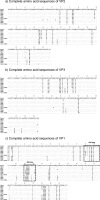Antigenic and receptor binding properties of enterovirus 68
- PMID: 24371050
- PMCID: PMC3958110
- DOI: 10.1128/JVI.03070-13
Antigenic and receptor binding properties of enterovirus 68
Abstract
Increased detection of enterovirus 68 (EV68) among patients with acute respiratory infections has been reported from different parts of the world in the late 2000s since its first detection in pediatric patients with lower-respiratory-tract infections in 1962. However, the underlying molecular mechanisms for this trend are still unknown. We therefore aimed to study the antigenicity and receptor binding properties of EV68 detected in recent years in comparison to the prototype strain of EV68, the Fermon strain. We first performed neutralization (NT) and hemagglutination inhibition (HI) tests using antisera generated for EV68 strains detected in recent years. We found that the Fermon strain had lower HI and NT titers than recently detected EV68 strains. The HI and NT titers were also significantly different between strains of different genetic lineages among recently detected EV68 strains. We further studied receptor binding specificities of EV68 strains for sialyloligosaccharides using glycan array analysis. In glycan array analysis, all tested EV68 strains showed affinity for α2-6-linked sialic acids (α2-6 SAs) compared to α2-3 SAs. Our study demonstrates that emergence of strains with different antigenicity is the possible reason for the increased detection of EV68 in recent years. Additionally, we found that EV68 preferably binds to α2-6 SAs, which suggests that EV68 might have affinity for the upper respiratory tract.
Importance: Numbers of cases of enterovirus 68 (EV68) infection in different parts of the world increased significantly in the late 2000s. We studied the antigenicity and receptor binding properties of recently detected EV68 strains in comparison to the prototype strain of EV68, Fermon. The hemagglutination inhibition (HI) and neutralization (NT) titers were significantly different between strains of different genetic lineages among recently detected EV68 strains. We further studied receptor binding specificities of EV68 strains for sialyloligosaccharides using glycan array analysis, which showed affinity for α2-6-linked sialic acids (α2-6 SAs) compared to α2-3 SAs. Our study suggested that the emergence of strains with different antigenicities was the possible reason for the increased detections of EV68 in recent years. Additionally, we revealed that EV68 preferably binds to α2-6 SAs. This is the first report describing the properties of EV68 receptor binding to the specific types of sialic acids.
Figures





References
-
- Schieble JH, Fox VL, Lennette EH. 1967. A probable new human picornavirus associated with respiratory diseases. Am. J. Epidemiol. 85:297–310 - PubMed
-
- Khetsuriani N, Lamonte-Fowlkes A, Oberst S, Pallansch MA. 2006. Enterovirus surveillance—United States, 1970–2005. MMWR Surveill. Summ. 55:1–20 - PubMed
-
- Centers for Disease Control and Prevention. 2011. Clusters of acute respiratory illness associated with human enterovirus 68—Asia, Europe, and United States, 2008–2010. MMWR Morbid. Mortal. Wkly. Rep. 60:1301–1304 http://www.cdc.gov/mmwr/preview/mmwrhtml/ss5508a1.htm - PubMed
Publication types
MeSH terms
Substances
LinkOut - more resources
Full Text Sources
Other Literature Sources
Research Materials

